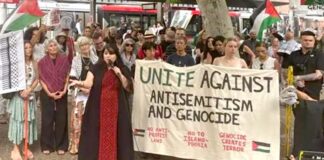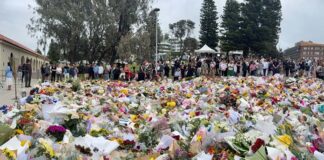Israel has never been willing to allow any kind of Palestinian state. The solution is to fight for a single democratic state with equal rights for Jews and Arabs, argues Luke Ottavi
Western politicians continue to pretend that a two-state solution can end Israel’s violence against the Palestinians.
US President Joe Biden talks of the “need to renew our resolve to pursue this two-state solution” and Australian Foreign Affairs Minister Penny Wong tells us that the “two-state solution is the only way the Israel-Palestine conflict can be solved.”
But the US and the West have known for years that the two-state solution has been dead in the water.
In July this year Netanyahu told an Israeli parliamentary committee that Palestinian hopes of establishing a sovereign state “must be eliminated”.
The two-state solution is nothing but a fig leaf to cover for the West’s continuing support for the apartheid regime of Israel.
The Oslo Accords
Plans for a two-state solution emerged from the Oslo peace process, formalised with the signing of the Oslo Accords in 1993 between the then leading resistance group, the Palestinian Liberation Organisation (PLO) and Israel.
Many Palestinians hoped that after years of struggle and sacrifice, real progress was being made towards an independent state.
But as Palestinian academic Edward Said argued at the time, the Accords were “an instrument of Palestinian surrender.”
The only reason Israel began serious negotiations was because of the First Intifada in 1987, and because the following year the PLO made the major concession of recognising the state of Israel and its “right to exist”.
The First Intifada erupted after decades of occupation and oppression. The rebellion lasted nearly five years and inspired similar revolts across the Middle East.
Palestinians revolted against the misery of occupation, taking Israel, the US, and the PLO by surprise.
Palestinian youth threw stones against armoured cars, hundreds of thousands mobilised in the streets of the Occupied Territories, and networks of local committees sprung up to provide health care and education.
Palestinians inside Israel itself—those who had not been forced out during the Nakba—joined a general strike in solidarity with striking workers in the Occupied Territories.
The scenes of oppressed Palestinians rising up against their oppressor started to break Israel’s carefully cultivated image of being a plucky David facing an Arab Goliath. Israel continues to falsely claim that they are the victims as they massacre men, women, and children in Gaza with thousands of bombs and white phosphorous supplied by the West.
But the PLO would betray Palestinians’ hope for liberation by ceaselessly compromising with their oppressor.
Concessions
When the PLO recognised the Israeli state in 1988, it abandoned the goal of liberating the whole of Palestine.
This meant giving up the 80 per cent of Palestinian land occupied by Israel since 1948, and in return hoping for a Palestinian “mini state” alongside it based on the West Bank and Gaza, occupied by Israel since 1967.
But the Oslo Accords left fundamental questions unanswered, such as when Israel would withdraw from Gaza and the West Bank and when a Palestinian state might be formed.
There was merely a “declaration of principles” for future negotiations.
Israel never had any intention of allowing the establishment of a Palestinian state—no matter how small and powerless.
Israeli leaders have always wanted complete control of the West Bank and Jerusalem. Since 1967 Israel has been relentlessly moving settlers into the occupied territories and gradually driving Palestinians off the land.
Immediately after the “peace process” began in 1993 Israel rapidly built large city-like settlements in the West Bank, annexing the surrounding land.
In the following ten years Israel increased the number of settlers in the West Bank at twice the rate of the previous 20 years.
The Israeli settler population in the West Bank in 1993 was 110,000, but there are now over 700,000 settlers living in the West Bank and Occupied East Jerusalem.
Israel defends the settlements with ruthless military force and controls roads and checkpoints across the West Bank. Palestinians have their freedom of movement restricted. They must pass Israeli military checkpoints to go to work, school, see family, or go to hospital.
The settlements and associated infrastructure, the Israeli-only highways, and the 700-kilometre concrete apartheid wall, means that Israel controls over 60 per cent of land in the West Bank.
Israel also controls the major aquifers in the West Bank and Gaza, completely determining
how much freshwater Palestinians have access to.
Israeli settlements and outposts are so widespread across the West Bank that, if left in place, they would guarantee a permanent Israeli military presence in any future Palestinian state.
The Palestinians would at best be left with a series of small, disconnected enclaves with Israel in complete control of movement between them.
The extent of Israeli control means it is impossible for an independent Palestinian economy to exist in the West Bank, let alone Gaza.
Before the Intifada, one third of Palestinians in the West Bank and Gaza worked in Israel. By 1996, as a result of Israeli restrictions, that had collapsed to 15 per cent. Earnings from work in Israel dropped from 25 per cent of Palestinian GDP to 6 per cent.
Israel can impose border closures to prevent Palestinians from exporting goods to regional and international markets.
In Gaza, periodic Israeli bombing has killed livestock, uprooted olive trees, and wiped food factories off the map.
The siege of Gaza meant half the population before October 7 were unemployed, and almost 70 per cent suffered food insecurity.
Israel and the West always claim that Hamas is the barrier to peace. But it is Israel that has sabotaged any “peace process”.
Hamas has made it known for years that it would accept a Palestinian state in the West Bank and Gaza and was open to negotiations with Israel. It made this explicit when it updated its Charter in 2017, although it has never given up its commitment to resistance or recognised Israel’s legitimacy as a state.
The Palestinian Authority (PA) established under the “peace process” was given limited control in the West Bank and Gaza. This was presented as a step towards a Palestinian state. Instead Israel demanded the PA take on the role of policing Palestinian resistance in the West Bank on behalf of Israel and suppressing political protest and expression.
Accepting this has transformed the PLO into abject collaborators with Israeli occupation and apartheid.
The PA has arrested dozens of journalists and union organisers and beat to death the prominent Palestinian activist, Nizar Banat, due to his exposing of PA corruption.
A poll in June 2023 found that 63 per cent of Palestinians in the Occupied Territories considered the PA operated in Israel’s interests.
A recent poll conducted during the war on Gaza found that support for the PA amongst Palestinians in the Occupied Territories has plummeted to just 10 per cent.
PA President Mahmoud Abbas was elected once in 2005, but has refused to hold another election for the last 16 years. In 2006 his party, Fatah, lost an election to Hamas but managed to keep control in the West Bank with US and Israeli support, while Hamas took control in Gaza.
Israel regards the PA as a crucial mechanism for maintaining its apartheid system in the West Bank. Netanyahu says that Israel “needs the PA… we cannot allow it to collapse… It does our job for us.”
Attempting to impose the PA in Gaza once Israel’s direct military occupation and bombardment has finished would solve nothing, even if it were possible. Palestinians have no interest in supporting a collaborationist political body that enforces apartheid, and seeks favour with the US who gives Israel the bombs to massacre Palestinians.
One state
The impossibility of a two-state solution has meant there is greater interest in, and acceptance of, a one-state solution.
Israel is a fundamentally racist society. Its very existence is premised on the ethnic cleansing and oppression of the Palestinians, and its self-proclaimed status as an exclusively Jewish state.
The Zionist foundations of Israel require maintaining a state with an overwhelming Jewish demographic majority.
Virulent racism towards Palestinians—captured succinctly by Israeli Defence Minister Yoav Gallant’s proclamation that Israel is fighting against “human animals”—is used to justify 75 years of occupation as well as the genocide presently unfolding before our eyes.
Any solution that does not entail the dismantling of Israeli apartheid and the right for Palestinians expelled from Israel in 1948 to return to their homes will not deliver justice.
The only real solution in Palestine is a single secular democratic state where Jews and Arabs live with equal rights and equality before the law.
This may seem like an impossible dream.
But the heroic fight against apartheid in South Africa shows how such a racist system can be dismantled.
However, unlike in South Africa where the Black working class held enough economic power to break apartheid, Israel systematically excludes Palestinians from its economy and is propped up by Western imperialism—principally the US. Palestinians, alone, do not have the economic or military strength to defeat Israel. But their resistance inspires struggle across the Middle East.
To break Israeli apartheid will require revolutionary struggle in the Arab countries surrounding Israel, particularly Egypt, to end the imperialist control of the region, alongside an international solidarity movement that breaks the US and Western governments’ support for Israel.
Anything less will mean the continued slaughter of Palestinians and the continuing of the occupation.
The breakout of Gaza on 7 October showed to the world that Israel is not invincible. Since then mass demonstrations around the world opposing the horror Israel is inflicting on Gaza, including in Israel’s key sponsor the US, have pointed to the power that makes revolution possible.




